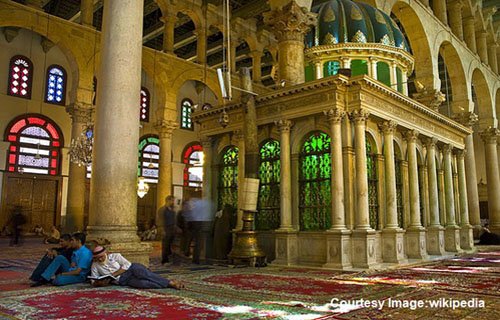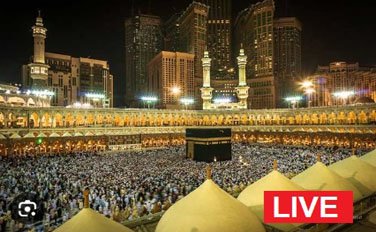The Shrine of Yahya (عليه السلام) in Damascus
Whispering of prophets and echoing with reverence, the Shrine of Yahya (AS) stands as a powerful symbol of unity in Damascus, Syria. Revered in Islam as John the Baptist (AS), this sacred site reflects the deep respect Islam holds for shared Abrahamic traditions. More than just a shrine, it serves as a bridge between faiths, a testament to the rich tapestry woven by these interconnected religions.

- Yahya (عليه السلام) is mentioned by name 5 times in the Holy Quran. He is the only Prophet whose name was chosen for him exclusively by Allah (ﷻ).
- Despite his age and lack of wealth, Prophet Zakariya (AS) faithfully served his community through daily sermons.
- His greatest concern was the lack of an heir to continue his work and guide the people.
- Visiting Mary (AS) in the temple, Prophet Zakariya (AS) found out-of-season fruit. Mary explained it was a gift from Allah. Inspired by this miracle, Zakariya prayed for a child despite his old age.
- Prophet Zakariya (AS), despite his age and barren wife, prays for a child after seeing a miracle with Mary (AS).
- Yahya (AS), born 6 months before Isa (AS), was Prophet Zakariya’s (AS) son granted through prayer.
- Yahya (AS) condemned Herod Antipas’ planned marriage to his niece Salome, calling it unlawful. This defiance angered the authorities, leading to conflict.
- Yahya (AS) publicly condemned Herod Antipas’ marriage plans, sparking outrage.
- Salome, the king’s niece, used her dance to manipulate Herod into promising her anything. She demanded Yahya’s head as revenge for his defiance.
- Blinded by desire, Herod agreed, and Yahya (AS) was executed.
A Place of Pilgrimage:
For centuries, the Shrine of Yahya (AS) has served as a destination for pilgrims and worshippers. Muslims revere John the Baptist as a prophet who heralded the coming of Prophet Muhammad (PBUH). Christians honor him as a key figure who prepared the way for Jesus Christ. This shared respect fosters a sense of unity and understanding within the shrine’s walls.
An Architectural Gem:
While the exact date of construction remains unclear, the Shrine of Yahya (AS) showcases exquisite Islamic architecture. The small, domed structure nestled within the Umayyad Mosque is adorned with intricate carvings and decorative elements. Its beauty reflects the reverence with which the shrine is held.
Early Islamic Period (7th – 8th Centuries CE)
- 7th Century CE: Following the arrival of Islam in the region, the Umayyad Mosque is constructed atop the ruins of a Roman temple and a later Byzantine church. The specific location of the Shrine of Yahya (AS) within the mosque complex is believed to mark the burial site of John the Baptist, revered in Islam as Yahya (AS).
Umayyad Caliphate (661-750 CE)
- Uncertain Date: The exact date of the shrine’s construction remains unclear. However, historical accounts suggest that the Umayyad caliphs likely played a role in establishing a designated space to honor Yahya (AS) within the newly built mosque complex. This act reflected the respect Islam holds for figures revered in previous Abrahamic traditions.
Abbasid Caliphate (750-1258 CE)
- Potential Renovations: While no definitive records exist, some scholars theorize that the Abbasid caliphs may have renovated or embellished the Shrine of Yahya (AS) during their rule. The Abbasid period witnessed a flourishing of Islamic arts and architecture, and it’s possible this extended to the beautification of revered shrines.
Later Eras (13th Century CE – Present Day)
- 13th Century CE – 19th Century CE: The Shrine of Yahya (AS) continues to be a revered pilgrimage site for Muslims throughout history. However, information regarding specific renovations or modifications during this period is limited.
- 20th – 21st Centuries CE: The Umayyad Mosque complex, including the Shrine of Yahya (AS), undergoes restoration efforts.
- Present Day: The Shrine of Yahya (AS) remains a significant landmark within the Umayyad Mosque. It features a small dome and an ornate silver grille enclosing the tomb. While photography is generally not permitted within the shrine itself, its presence serves as a constant reminder of the shared reverence for prophets across faiths.
A Legacy of Unity:
The Shrine of Yahya (AS) stands as a testament to the rich tapestry woven by Islam, Christianity, and Judaism, the Abrahamic religions. It embodies the core Islamic principle of respect for prophets who came before Prophet Muhammad (PBUH). For centuries, the shrine has fostered a sense of understanding and unity between Muslims and Christians who revere John the Baptist/Yahya (AS).
A Beacon of Faith:
Today, the Shrine of Yahya (AS) continues to attract pilgrims and visitors from all walks of life. It serves as a powerful symbol of religious tolerance and a reminder of the importance of honoring figures who paved the way for Islam. The shrine’s enduring presence within the Umayyad Mosque complex underscores the deep respect Islam holds for its Abrahamic roots.
References: Own Research, Wikipedia
Please note that this entry is provided for informational purposes only. It is imperative not to engage in praying to graves or seeking supplication through them, as this constitutes associating partners with Allah (ﷻ), which is strictly prohibited.
Related Post: Jordan’s Gems:Historical Mosques and Places
Also Read: The Minaret of Isa (عليه السلام)
May You Like: Makkah : Holy Sites and History

